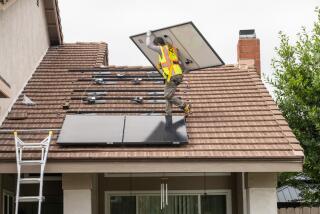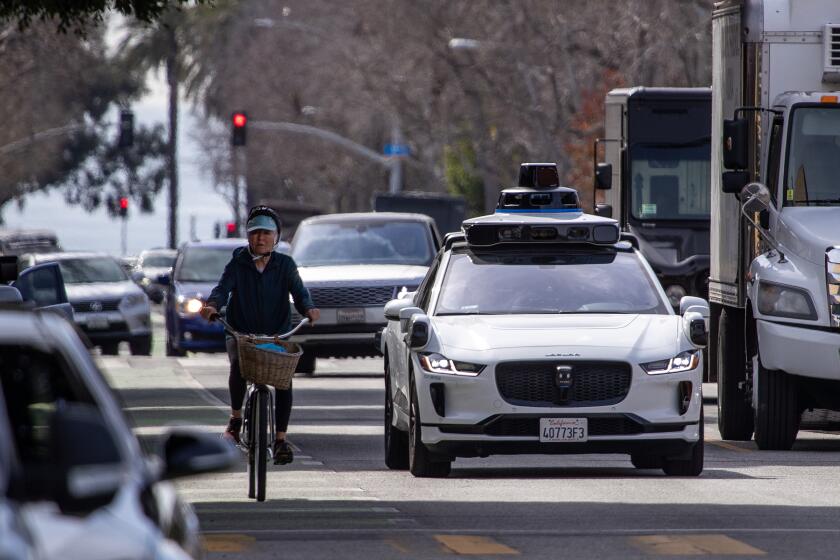Using the sun to keep cool
- Share via
Everyone knows solar power can heat homes and generate electricity.
But on a rooftop in Downey, Southern California Gas Co. engineers are using solar mirrors to cool down their offices.
Engineers are testing two technologies that use mirrors to concentrate sunlight onto pipes with water running through them. The heated water powers a thermal process in a chiller that cools the cold water used in air conditioning units.
“When we tell people we heat water up only to cool it down, they don’t get it at first,” said David Berokoff, a technology development manager at SoCal Gas. “But all this technology has been around for a while. We’re just trying to bring it together so we can get it out to our customers as soon as possible.”
The initiative is the latest in a move by SoCal Gas and its parent, Sempra Energy, to wean businesses off gas and push them to use more solar power. For businesses, the technologies could mean substantial savings.
Beyond the potential environmental benefits -- the sun is a nonpolluting, renewable source of energy -- the solar systems undergoing tests could help businesses slash air conditioning costs as much as 60%, Berokoff said.
The effort may seem counterproductive for one of the nation’s largest natural gas distributors, but it’s part of a broader move by the company to reposition itself as a renewable energy provider, SoCal Gas officials said. Sempra, which also owns San Diego Gas and Electric Co., expects to spend $10 million this year researching and developing “green technologies.”
The research project is only 4 months old and solar-powered cooling probably won’t reach the gas company’s customers for another year or two, but the gas company is already wooing businesses to the rooftop of its Downey research facility.
“When they make an investment in this sort of technology, they are in fact keeping their company viable and making sure they are changing as their customers’ needs change,” said Bob Phillips, a spokesman for Coca-Cola Bottling Co. of Southern California, which is watching the tests to see whether such technologies would make sense for several of its bottling plants. “It’s a very long-term view, but it’s the right view to have.”
The gas company has been checking out competing solar-thermal cooling technologies from two companies to see which would work best on the roofs of warehouses, manufacturing plants and other commercial buildings.
The research could cut the cost of the systems and bring them to market sooner, Berokoff said.
The rooftop prototype systems, which include the mirrors, pipes and computer-automated solar trackers, cost about $200,000 each -- about the same cost as the entire traditional air conditioning system installed in the 45,000-square-foot Downey building, he said.
The developers hope to slash that price by at least half before it reaches commercial customers.
SoCal Gas is comparing systems developed by Sopogy Inc., based in Honolulu, and HelioDynamics of Britain. The testing is expected to run until the middle or end of next year, he said, after which SoCal Gas plans to compare the results with similar mirror-based systems from other manufacturers.
Sopogy’s and HelioDynamics’ systems are similar: Both use mirrors to aim the sun’s rays at water pipes, and when sun isn’t available to heat the water -- at night, for example -- both rely on gas as a backup.
The differences between the two systems lie in the shape and size of the mirrors used and in the placement of the water pipes.
Sopogy uses several 12-foot mirrors that curve upward, reflecting sunshine onto a pipe running just above the center of each mirror. HelioDynamics uses slabs of small, flat mirrors that reflect the sun’s rays onto a single pipe above them.
Both systems use computer-automated trackers to tilt the mirrors throughout the day as the sun moves across the sky.
The hot water in both systems is heated to temperatures just under 200 degrees and collected in a storage tank. Then it goes through an absorption chiller that cools the cold water used in the building’s fan units.
Non-solar systems use gas or electricity to heat the hot water before it goes through the chiller.
Sempra likes that the two solar systems can work alongside existing gas and electric systems, said Hal Snyder, vice president of customer solutions for SoCal Gas.
“People want renewable sources of energy, but we don’t think people want a switch that just happens overnight,” Snyder said. “By using gas or electricity as a backup, we’re not having to replace our infrastructure, and our customers know they won’t have to get into something experimental.”
The demonstrations are also helping developers of the technology, said Al Yuen, Sopogy’s director of corporate development.
“The gas company is giving us a stage to demonstrate what we can do for their customers,” Yuen said. “They bought our mirrors, bought our system, and now they’re using it and showing it off. It helps tremendously.”
Another benefit for the developers, Yuen said, is seeing the systems in daily use, up against competitors’ -- with all the information shared.
This information from the project will be a deciding factor for most SoCal Gas and Sempra customers when the technology hits the market, Coca-Cola’s Phillips said.
“It’s easier to take that plunge when you have an example of the technology in place and you can point to numbers and say, ‘That’s effective, that saves money, that’s worth doing,’ ” he said.
--
nathan.olivarezgiles@ latimes.com
More to Read
Inside the business of entertainment
The Wide Shot brings you news, analysis and insights on everything from streaming wars to production — and what it all means for the future.
You may occasionally receive promotional content from the Los Angeles Times.










